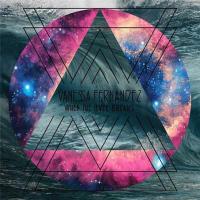"When the Levee Breaks" Re-Grooves The Songs of Led Zeppelin
Vanessa Fernandez tackles the Led Zeppelin assignment with an occasionally seductive feline intensity, growling and purring where necessary. She convinces on the banshee call opener “Immigrant Song”, which is followed by the crucial “Black Dog”. Fernandez either seduces or your eyes roll. I bought it.
That took care of side one. Each side of the three 180 LPs cut at 45rpm has but two songs. Side two’s “Kashmir”, the lacquer of which you can listen to elsewhere on this website paired with “Trampled Under Foot” also kept me on the program, though, to my ears, the violin opening of “Kashmir” had less desert intrigue and more “A Fiddler on the Roof” schmaltz (the rest of the violin part better navigates the emotional terrain, while filling the space with needed edge and grain).
The acoustic “When the Levee Breaks” didn't work as well as the others for me, but Ms. Fernandez brought to “The Lemon Song” the ferocity found on her previous Groove Note album Use Me and that saved the side.
The fourth side pairs “Whole Lotta Love” with “Ramble On” and by the time you get here, maybe you are saying to yourself “it’s good that the album is spread onto three slabs of vinyl with two songs per side”, because while overall Ms. Fernandez does a great job and Tim Pierce’s mostly spare acoustic arrangements are refreshing, after a while a formulaic sameness sets in and less becomes more.
Redoing “Whole Lotta Love” acoustically is a thankless task for anyone in my opinion but the well arranged “Ramble On” with Jim Keltner on drums rights the ship.
The third record begins with “Babe, I’m Gonna Leave You”, which Plant and Page learned from Joan Baez In Concert, and backed by Keltner on drums and Jim Cox on organ, Fernandez puts forth among her best vocals on the record, producing an intensity level that in a few other places she can’t quite summon. That’s followed by a reprise of “The Immigrant Song” that’s filler.
The final side contains two LP-only bonus tracks: an alternative mix of “Babe I’m Gonna Leave You” and a hard-core, rocking electric version of “Whole Lotta Love” that Fernandez delivers sultry, an octave down and close to the microphone.
This was a grand musical experiment, risky and costly for the producer Ying Tan, recorded all-analog by Michael C. Ross at United Recording (formerly Ocean Way). Spread to three records means it was also costly to press and required a triple gatefold package, that the producer went all out to make special and it certainly is. It's one of the reasons we buy and love vinyl—in addition of course to the sound.
The arrangements and the playing, especially Tim Pierce’s acoustic guitars and Keltner’s drumming, are, for the most part, musically rewarding and Fernandez delivers the goods most of the time.
When she’s not sure how to end a phrase Fernandez goes into a soft, wobbly vibrato that she uses a few times too many, but that’s not really her fault: the acoustic around her voice is spare and dry, leaving her no room to melt into reverb.
This is an “audiophile” production that aims for a certain “absolute sound” of a band and a singer playing in a space and in that regard it is 100% successful but it also produces a “literalness” not found on “commercial” recordings.
The result is a spectacularly natural and ultra-dynamic drum sound similar to what Glyn Johns achieved on the latest Eric Clapton album. Tim Pierce’s guitars are equally well-served in a recording by Michael C. Ross that’s nothing short of stupendously transparent, dynamic and natural.
Fernandez’s voice is presented in an equally literal manner, but that left her no room for the kind of electronic support singers regularly get on more commercial productions. She deserves mega-credit for performing so well under such difficult recorded conditions!
I’m reminded of something I read while researching London’s Royal Festival Hall, which was built directly after World War Two according to “scientific principles” as was Avery Fisher Hall some years later.
Both suffered from serious acoustical problems. The Royal Festival Hall’s dryness (long since ameliorated) caused the conductor Simon Rattle to remark that the dry acoustics make performers who play in it “…lose the will to live".
Fernandez clearly didn’t “lose the will to live” and enjoyed working on the record and that comes through on every track. I just think some reverb, some effects and some production other than “playing live in a studio space” might have jacked up the excitement and brought some surprises to the sonic sameness, spectacular as it is…and it is spectacular.
The original plan was to mix "live to lacquer" from a remote truck parked outside Bernie Grundman Mastering but the logistics, including getting the necessary permits, proved too difficult so it was mixed down to tape. In the end that proved to be the better choice, because it didn't limit the amount of time Ross could devote to mixing down the two inch twenty four track tape.
I’ll put it to you this way: if you play this record really loud and you don’t enjoy what you hear, blame your system!
Ultimately I don’t think you’ll come away from this record having gained new insight into the music of Led Zeppelin (which is probably not in need of “insight”), but in the process of not learning anything new, you will have had a great time! So crank it up, enjoy and don't think too much about it.




